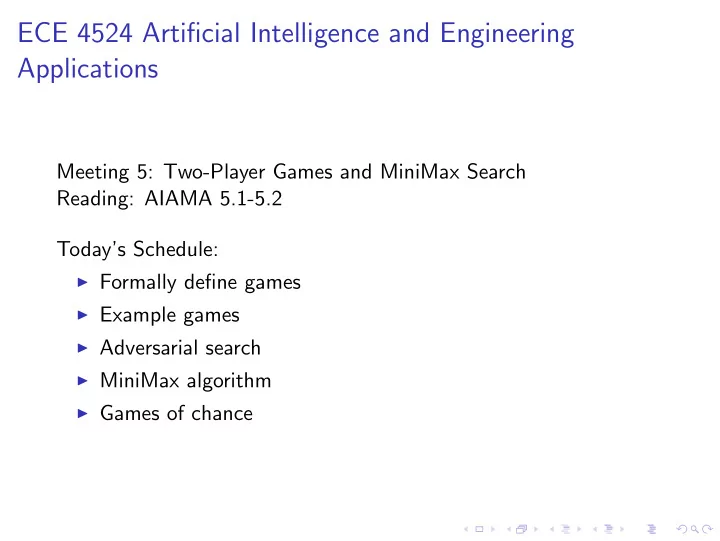

ECE 4524 Artificial Intelligence and Engineering Applications Meeting 5: Two-Player Games and MiniMax Search Reading: AIAMA 5.1-5.2 Today’s Schedule: ◮ Formally define games ◮ Example games ◮ Adversarial search ◮ MiniMax algorithm ◮ Games of chance
A review of Problem Solving Agents Problem Solving Agents formulate problems by ◮ representing (model) the world as atomic states , ◮ defining an initial state that represents the initial condition of the world, ◮ defining a goal state that represents what they want the world to look like, ◮ and defining a function for allowable state transitions which map onto actions in the world.
Define games and adversarial search A game is a multi-agent environment where actions are (usually) taken in turns. Agents do not have full control over the environment and so must ◮ take into account contingencies, other agent’s actions ◮ take into account competition, other agent’s goals This leads to adversarial search .
Game Terminology Lets use tic-tac-toe to help explain the terminology. A game tree is made up of ◮ Initial State ◮ Player(s) ◮ Actions(s) ◮ Results(s,a) ◮ Terminal-Test(s) ◮ Utility(s,p)
Game Terminology Lets use tic-tac-toe to help explain the terminology. A game tree is made up of ◮ Initial State ◮ Player(s) ◮ Actions(s) ◮ Results(s,a) ◮ Terminal-Test(s) ◮ Utility(s,p)
Game Terminology Lets use tic-tac-toe to help explain the terminology. A game tree is made up of ◮ Initial State ◮ Player(s) ◮ Actions(s) ◮ Results(s,a) ◮ Terminal-Test(s) ◮ Utility(s,p)
Example NIM Nim is a simple game that is useful to illustrate game play. Here is the variation we will consider. There three piles of tokens with initially a given number in reach pile. The players take turns removing tokens under the following rules: ◮ Each turn the player must take at least one token, and ◮ You can take multiple tokens, but only from the same pile. The game is won by the player taking the last tiles (none remain after the turn).
Warmup #1 Consider the following initial condition for Nim Pile 1 = 3, Pile 2 = 4, Pile 3 = 5 defined as (3,4,5) What are the states of the game at the next ply depth written as triplets of numbers?
Other Examples: Checkers and Chess
Game On! Lets play some Nim to get an idea of strategy. Pick a partner and play a few rounds starting at 3,4,5. Sketch your game tree.
Cartoon Example Consider the following game tree with the utility filled in at the terminal nodes. Assume the max player goes first. What is the rational move to make?
Minimax Search
Warmup #2 Suppose a Nim game starts with configuration (1,1,1) and that max goes first. Perform minimax search assuming a win for max has utility +1 and -1 if min wins. What is the backed-up minimax value?
Exercise Assuming max goes first, what it the rational action to take?
Time limits and real-time decisions ◮ Most games have a time limit and a state space that prohibits reaching terminal states. ◮ So, we cut-off the search at a specific depth and use a heuristic, called the evaluation function, to estimate what would be the backed-up value. This is required for many games, e.g. chess.
Is there something smarter we can do?
Extensions to games of chance Stochastic games have an element of chance, for example from the roll of a the dice. We can introduce chance-nodes to account for this. The backed-up value is then the Expected Utility .
Example: Dice based 21
Practical Applications of Adversarial Search So this is all not just fun-and-games (pun intended). ◮ Game theory is important in many areas, notably economics ◮ It is often useful to model the environment as an adversarial agent, i.e. contigency plans ◮ Games of chance are good models of Sequential Decision Problems
Next Actions ◮ Reading on alpha-beta search and practical game considerations, AIAMA 5.3-5.4 ◮ Take warmup before noon on Thursday 2/1. Reminder! PS1 is due 2/12.
Recommend
More recommend